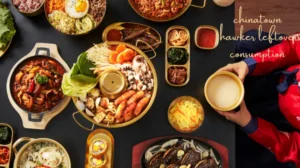Chinatown Hawker Leftovers Consumption: A Sustainable Tradition
Chinatown hawker leftovers consumption is a unique practice that blends cultural values, environmental consciousness, and economic practicality. In bustling hawker centers, especially in areas like Singapore’s Chinatown, the act of consuming leftovers is not merely about frugality; it’s a reflection of a community’s respect for food and commitment to sustainability.
Understanding Chinatown Hawker Leftovers Consumption

A Cultural Perspective
In many Asian cultures, particularly within Chinese communities, wasting food is considered disrespectful. This belief stems from historical experiences of scarcity and the value placed on resourcefulness. In Chinatown, this cultural ethos manifests in the practice of consuming leftovers, emphasizing gratitude for food and the labor involved in its preparation.
Economic Implications
For hawker vendors, managing food waste is crucial for profitability. By repurposing unsold dishes or offering them at discounted rates, vendors can minimize losses and provide affordable options to customers. This approach supports small businesses and ensures that food reaches those who might benefit from lower-priced meals.
Benefits of Consuming Hawker Leftover

Environmental Impact
Food waste contributes significantly to environmental degradation, producing greenhouse gases like methane when decomposing in landfills. By consuming leftovers, the community reduces this waste, conserving resources and mitigating environmental harm.
Community Building
Sharing leftover food fosters a sense of community. In Chinatown, it’s common for neighbors and friends to share meals, strengthening social bonds and promoting collective responsibility towards food consumption.
Safe Practices for Leftover Consumption
Proper Storage
To ensure safety, leftovers should be stored in airtight containers and refrigerated promptly. This practice prevents bacterial growth and maintains food quality.
Reheating Guidelines
Reheating leftovers to an internal temperature of at least 165°F (74°C) is essential to eliminate potential pathogens. Using appropriate methods like microwaving or stovetop heating can restore the dish’s original flavor and texture.
Creative Ways to Enjoy Leftovers

Transforming Dishes
Leftover rice can be stir-fried with vegetables and proteins to create a new meal. Similarly, grilled meats can be added to salads or sandwiches, and soups can be refreshed with additional ingredients, offering variety and reducing waste.
Challenges and Considerations
Health and Safety Concerns
While consuming leftovers is beneficial, it’s vital to be cautious. Food left out for extended periods may harbor bacteria, posing health risks. Ensuring proper storage and reheating is crucial to prevent foodborne illnesses.
Social Perceptions
Despite its advantages, some view leftover consumption negatively, associating it with poverty or lack of hygiene. Changing these perceptions requires education and awareness about the environmental and economic benefits of this practice.
Community Initiatives and Government Support


Food Donation Programs
Organizations collaborate with hawker centers to redistribute surplus food to those in need, reducing waste and supporting vulnerable populations.
Sustainability Campaigns
Government initiatives aim to reduce food waste by promoting recycling and responsible consumption, encouraging practices like leftover consumption in hawker centers.
FAQs
What is the limit on leftovers?
Leftovers should ideally be consumed within 3–4 days when stored properly in the refrigerator. Beyond this period, the risk of foodborne illness increases.
How long do Chinese leftovers last?
Chinese leftovers, like other cuisines, can last up to 4 days in the refrigerator. Proper storage in airtight containers is essential to maintain freshness.
Can I eat 7-day-old leftovers?
It’s generally not recommended to eat leftovers that are 7 days old, as the risk of spoilage and bacterial growth increases significantly after 4 days.
How many days does leftover takeout last?
Leftover takeout food should be consumed within 3–4 days if stored correctly in the refrigerator. Always check for signs of spoilage before consumption.
Conclusion
Chinatown hawker leftovers consumption embodies a blend of cultural respect, economic sensibility, and environmental responsibility. By embracing this practice, communities can reduce food waste, support local businesses, and foster stronger social bonds. With proper handling and a shift in societal perceptions, leftover consumption can play a significant role in building a sustainable future.













Post Comment